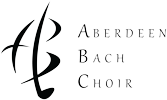J.S. Bach Mass in B Minor
Aberdeen Bach Choir
Musical Director Paul Tierney
Aberdeen Sonfonietta
Leader Bryan Dargie
Sunday 28th April 2024
Aberdeen Music Hall
Aberdeen Sonfonietta
Leader Bryan Dargie
Sunday 28th April 2024
Aberdeen Music Hall
J. S. Bach's Mass in b minor BWV 232 was completed in 1749, the year before the composer's death. The first UK performance of the Mass was given by The (London) Bach Choir newly formed by the conductor Otto Goldschmidt. This took place in 1876, in St James's Hall in London. After today's performance, a lady in the audience stopped me to say that no fewer than four generations of her family had sung in performances of this very work by The Aberdeen Bach Choir, so in many ways, this was a very special event.
Quite a few modern performances use a smaller orchestra with period instruments. Today's performance however took me back to earlier performances with a fairly large orchestra and modern instruments. In one case, there was something almost futuristic about one of the instruments. This was the organ played by David Gerrard, situated just below the conductor. The electronic keyboard was connected to the sound system of the Music Hall, the speakers just above the stage. This had been carefully set up so that the sound was very carefully and delicately even melded into the overall orchestral sound. Where the organ was meant to come through as part of the accompaniments to solo arias, the soprano's Laudamus Te for instance, it certainly came through clearly, although a separate small organ would have possibly sounded more distinct from the other instruments. Still, I thought what we heard on Sunday worked really well. Some recordings of the work employ two sopranos, but on Sunday, in the Christe eleison Elinor Rolfe Johnson was joined by counter-tenor Tom Lilburn. Before hearing them, I was not sure that this would work well, but in fact it did. The two lines of vocal music stood out clearly and they blended rather beautifully too. I was delighted.
Of course the soloists and orchestra are important in the work, but it is the choir that is crucial to a successful performance of this work, and right from the beginning, the voices of the Bach Choir were prodigious. They sounded absolutely epic in the opening Kyrie eleison, and the orchestra added superbly to the whole rejoicing spirit of the music. Actually Bach is amazing. His music can be made to work in so many performance styles, romantic, yes, or even jazz. Of course there was no jazz in this performance but wonderful rhythm there was a-plenty in the choral singing. The basses in the opening delivered marvellous rhythmic surges. Paul Tierney drew a sweeping smoothness from choir and orchestra in the opening of the work. There was certainly a feeling of the romantic in the music, a big glossy sound, and I loved it. After all Paul was delivering all the epic qualities of the work.
The choir could bring fire and energy to their singing as in the Gloria in excelsis Deo, but later on, in the slow music of the Crucifixus they could sound almost whisperingly gentle as the word was taken over by various sections of the choir before exploding with brightness in Et resurrexit supported by the fiery blaze of trumpets in the orchestra. As in parts of the St Matthew Passion, Bach provides some wonderful orchestral backings for his solo singers. Tom Lilburn's Qui sedes had oboe d'amore played by Geoffrey Bridge. The blend of voice and instrument was delicious. Leading the upper strings with his highly decorative solo, Bryan Dargie raised the impact of the fine easily soaring singing of soprano Elinor Rolfe Johnson. Baritone Jerome Knox whose diction was particularly brilliant was supported by splendid horn playing from Rachel Brady in Quoniam tu solus sanctus, her sound gleamed magnificently.
Margaret Preston's gorgeous flute, along with cello continuo played by Alison MacDonald and Callum Young on double bass lit up tenor soloist Nathan Vale's Benedictus qui venit, always an appealing part of the Mass. I must not forget Isabel John's timpani with the chorus in Gratias agimus tibi or the double bass players whose throbbing sound so often drove the rhythm of the music forward. Or the sense of animation that I watched conductor Paul Tierney give to the second Osanna in excelsis making sure that even near the end, the music kept its vibrancy.
Tom Lilburn's solo Agnus Dei with organ, upper strings and cello continuo was amazingly soft and gentle near the end of the work. Then came the explosive conclusion Dona Nobis Pacem. The chorus had worked hard all evening with a big big sing. Would they be too tired for this? No. As I have often said of the Bach Choir, they are seemingly tireless, and this concluding chorus was every bit as full of life as their opening.
Alan Cooper
Aberdeen Bach Choir
Scottish Registered Charity Number SC008609

